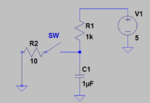welove8051
Full Member level 6
Hello, with respect to the below image how much will be current flow through the switch and resistor R2 when it is pressed?
assuming that the capacitor is fully charged and resistance offered by the switch is zero.
will it be 5V/10 = 0.5A. if that is the case then maximum current carried by the switch should be considered or not?
thanks

assuming that the capacitor is fully charged and resistance offered by the switch is zero.
will it be 5V/10 = 0.5A. if that is the case then maximum current carried by the switch should be considered or not?
thanks
